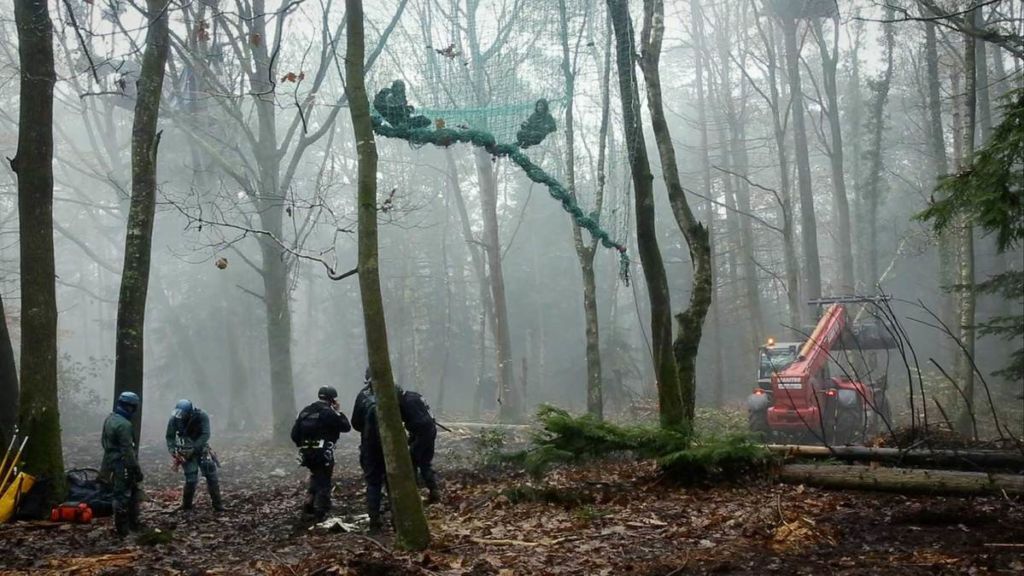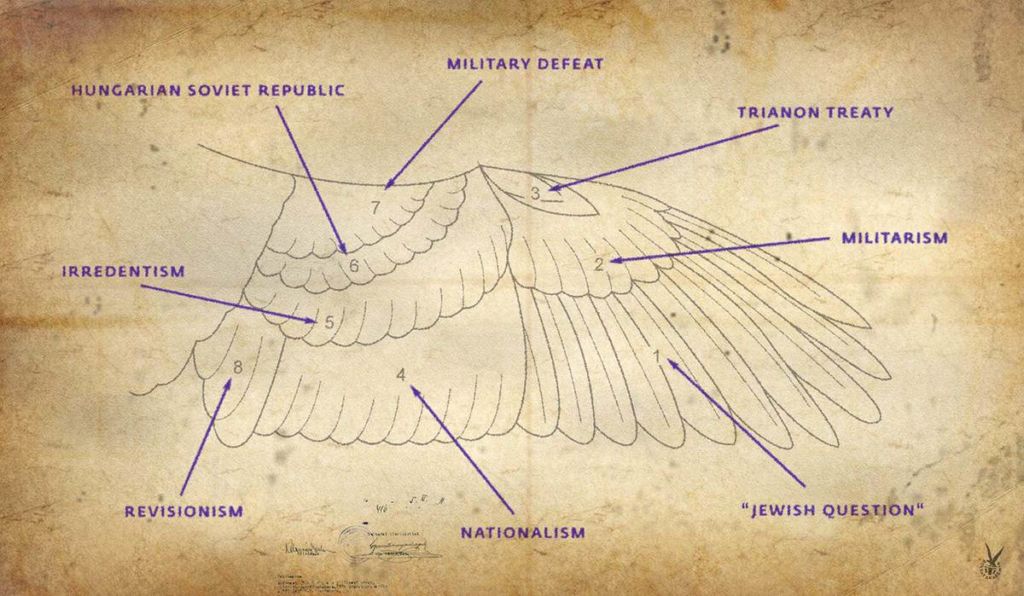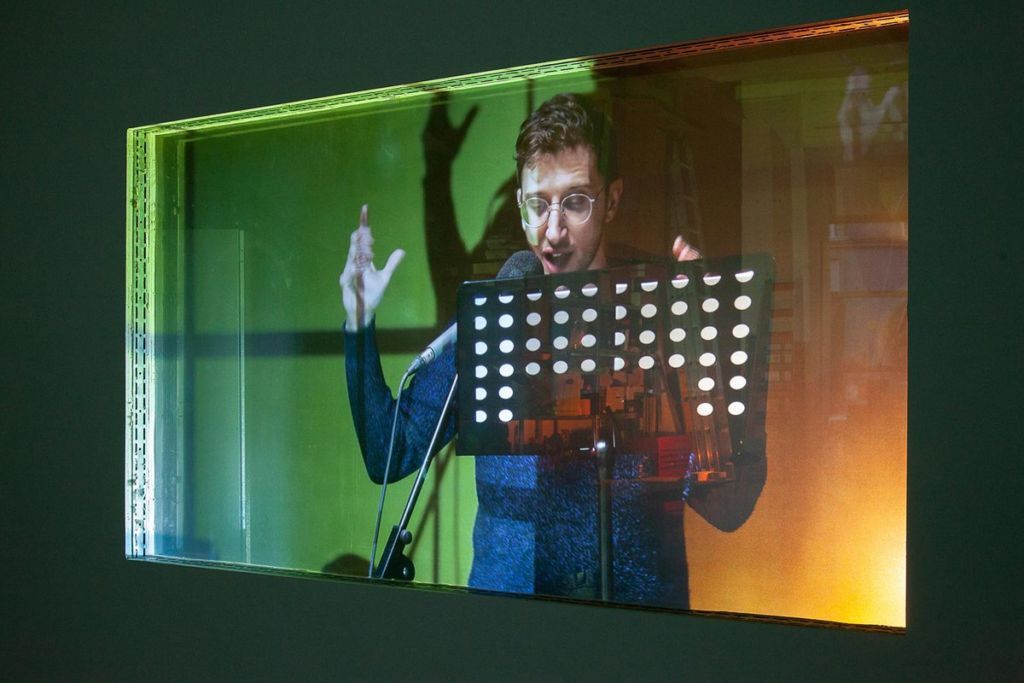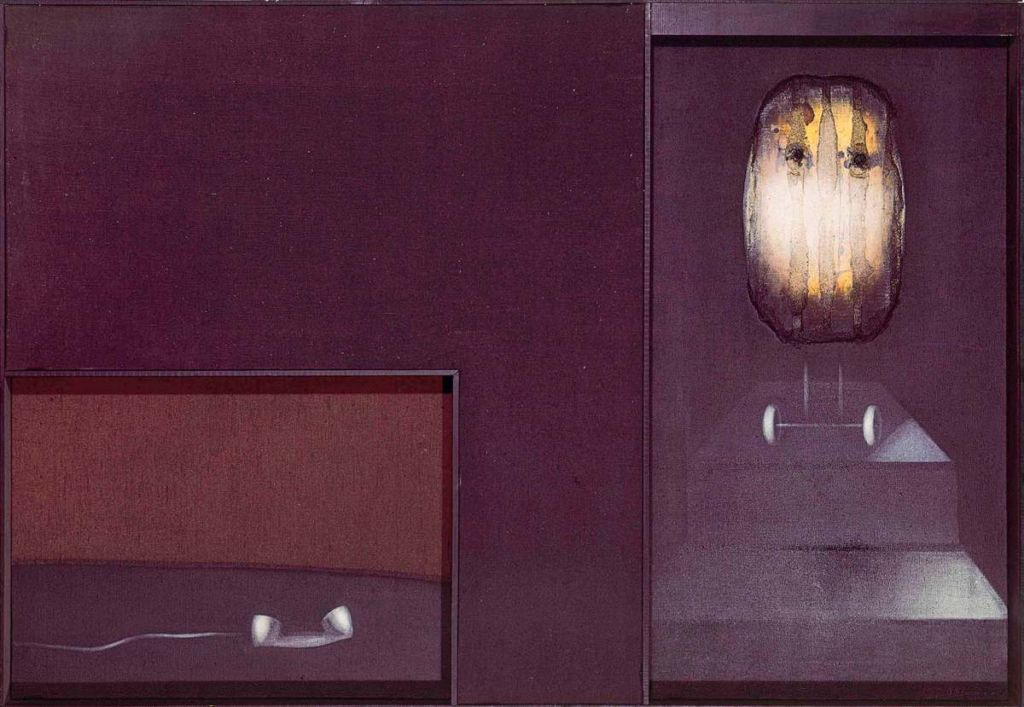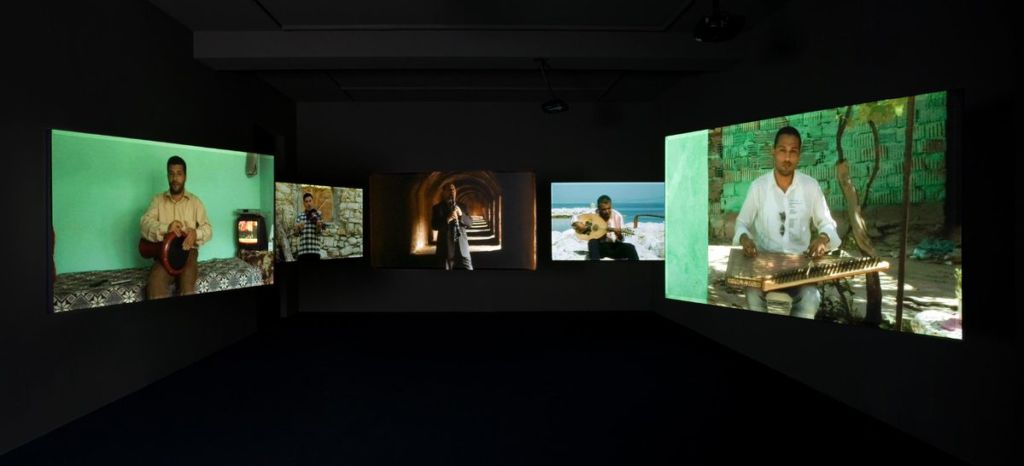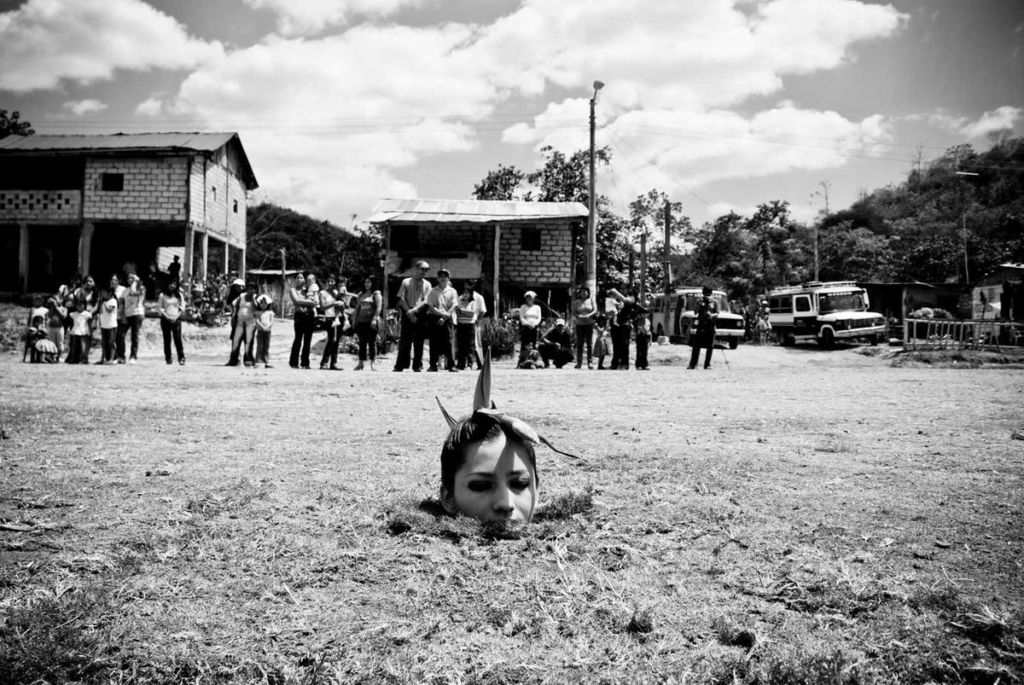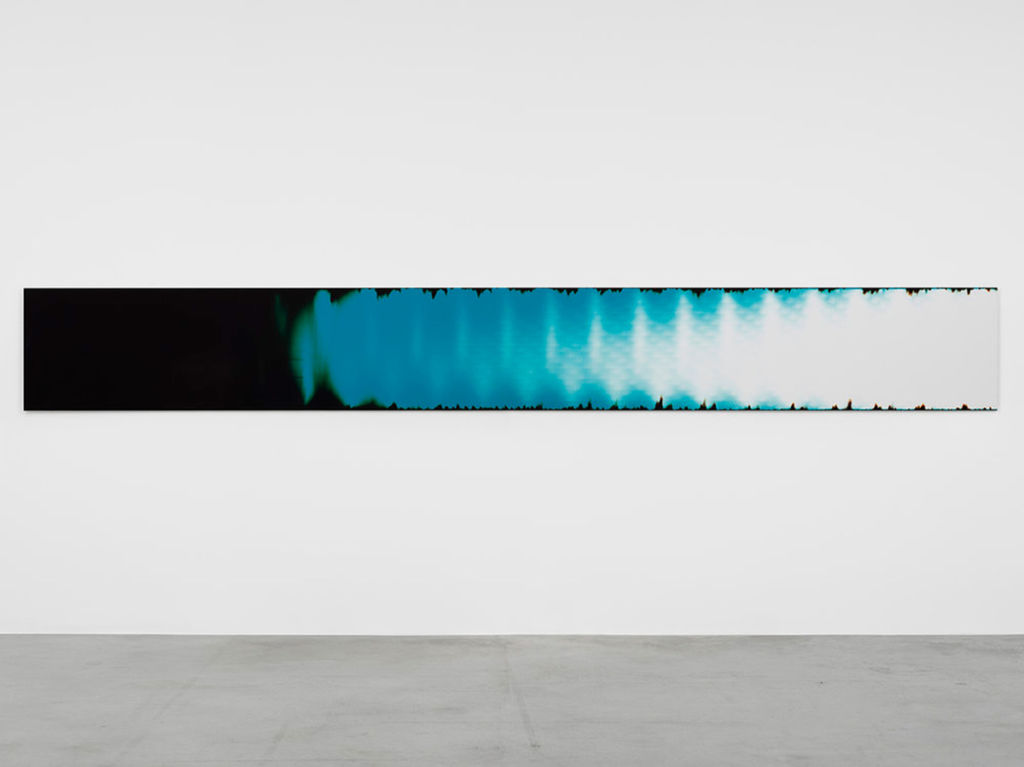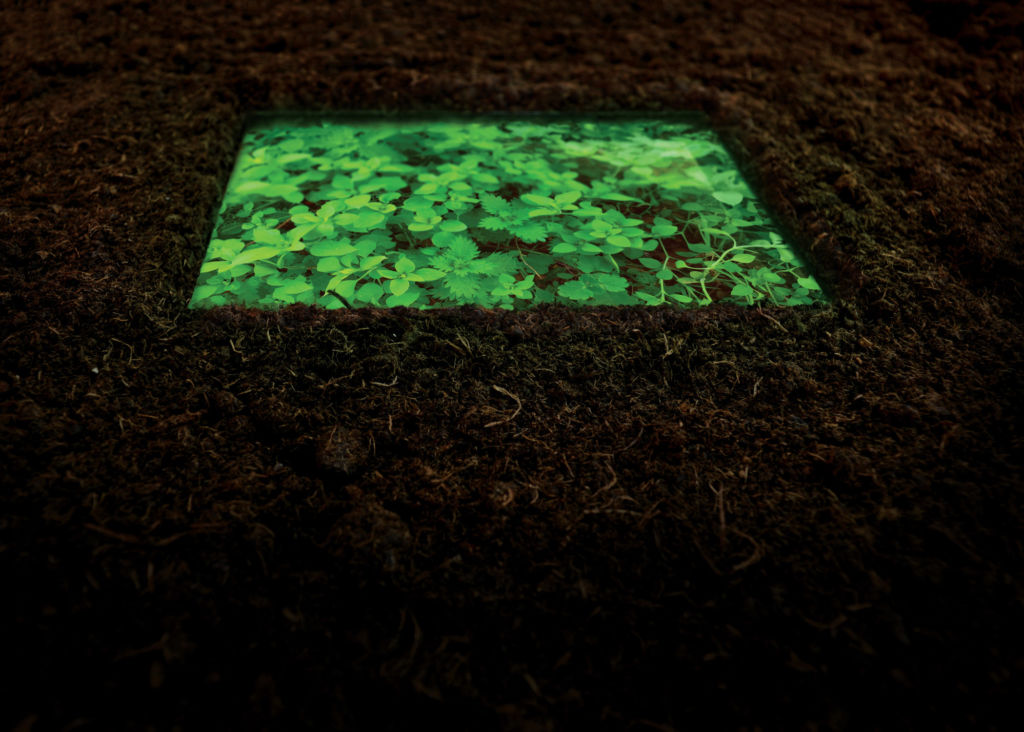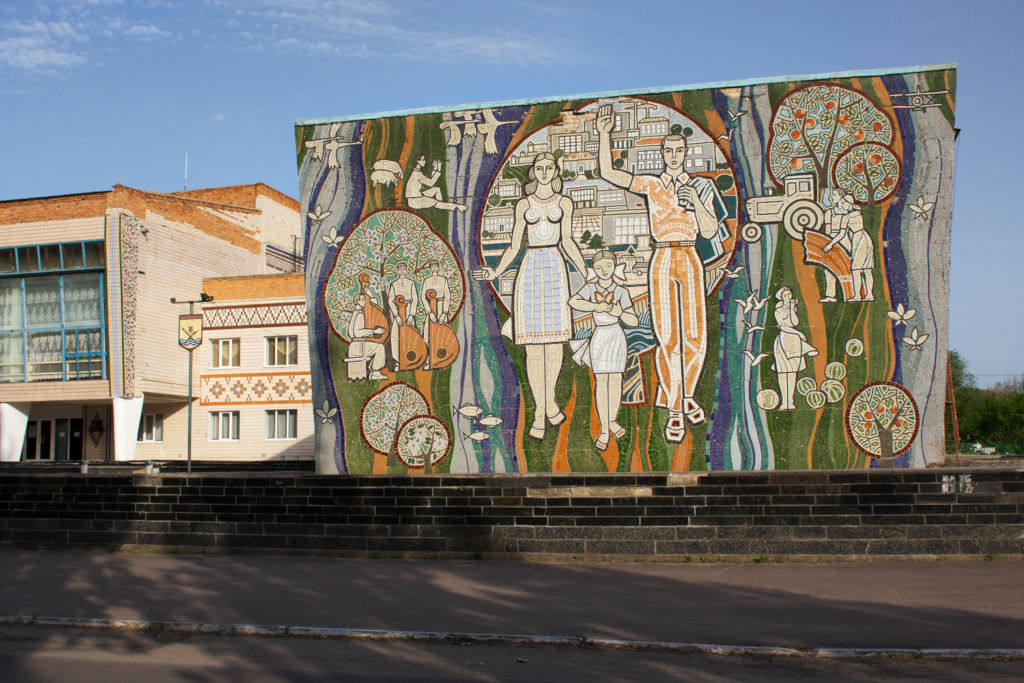The environmental problems, pollution and violence of extractive capitalism that we are facing today are closely connected with the ongoing process of global warming. Artist Oliver Ressler has addressed in recent project Everything’s Coming Together While Everything’s Falling Apart the ecological and climate issues of our time while following the actions of social movements for climate justice and the crucial events against the continuation of exploitation of fossil fuels.
Texte disponible uniquement en anglais
More about the climate justice movement
More info on the artwork greenhouse effect
More information about artwork for a completely different climate
More info on the problem of global warming is available at the web-page of the European Environmental Agency
Additional info about Carbon Majors Report
Additional info about Conference of the parties cop
Karl Marx “Capital, 1, p.595, Three Volumes; International Publishers, New York.
Jerome Roos “Living Through the Catastrophe.” 10 More information about the whole project can be found at: Everythings coming together
More information about the collaboration between Oliver Ressler and Matthew Hyland can be found in Oliver Ressler’s interview with Barnaby Drabble: Everythings coming together while everythings falling apart
More information about Renée Gadsden and her voice in community service
The entire film Everything’s coming together while everything’s falling apart Ende Gelände
More information about climate justice movement Ende Gelände
The entire film is available online Everything’s coming together while everything’s falling apart: The ZAD
More information about the ZAD
John Jordan is an artist and activist, co-founder of direct action groups Reclaim the Streets and the Clown Army. Together with Isabelle Frémeaux, he co-founded the art activism and permaculture collective The Laboratory of Insurrectionary Imagination
More information about the climate justice movement Limity jsme my
More information can be found here: Venice Climate Camp
More information about the organization No Grandi Navi
More information about the organization Fridays for Future
For additional texts On the biennales ruins inhabiting the void covering the distance by Marco Baravalle
In Marxist theory, Interpellation is an important term in relation to the notion of ideology in the work of the French Marxist philosopher Louis Althusser. All ideologies function with the help and through the constitution of the subject. Althusser calls “interpellation” (also knowns as “hailing”) the process by which ideological discourses constitute the subjects. Ideologies “hail” people and offer them a particular identity, which they accept as undeniable and, in this way, the dominant class exerts a power over individuals. Louis Althusser, Ideology and Ideological State Apparatuses (Notes towards an Investigation) in “Lenin and Philosophy and Other Essays,” (New: Monthly Review Press, 1971).
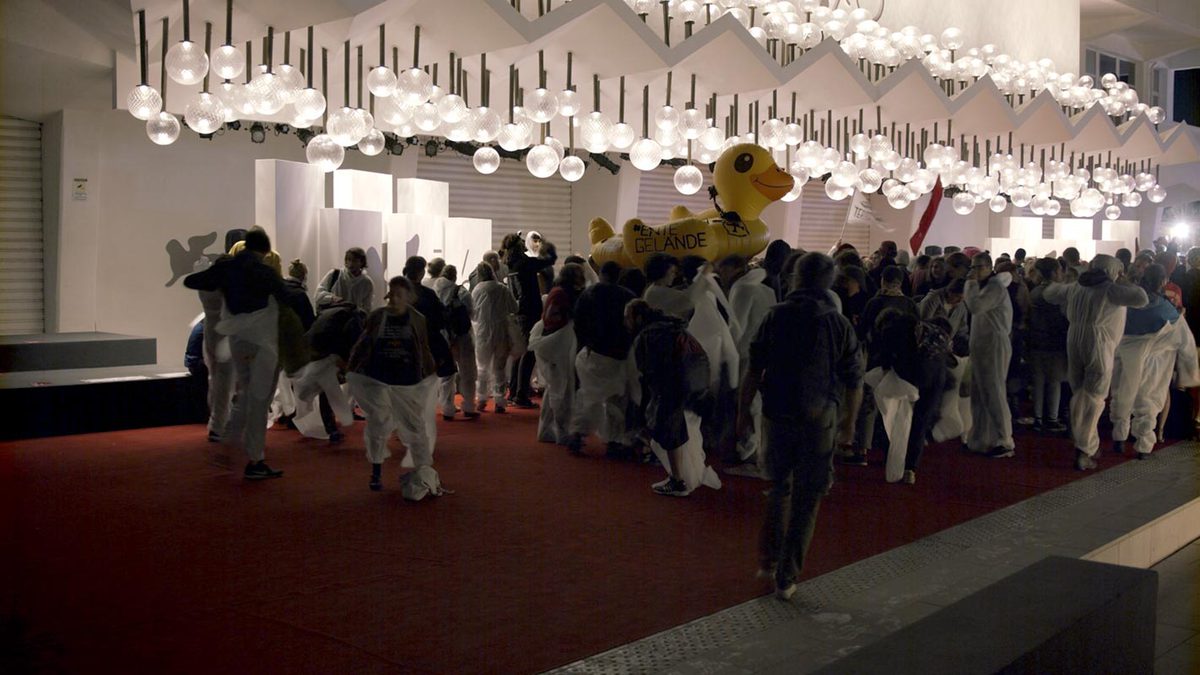
Oliver Ressler, “Everything’s coming together while everything’s falling apart: Venice Climate Camp”, 21 min., 4K, 2020. Courtesy the artist, àngels Barcelona, The Gallery Apart, Rome
The works of Austrian artist and filmmaker Oliver Ressler represent a vivid example of how contemporary art can reflect on socially and politically relevant issues. He produced installations and projects in public spaces, photographic installations and films, which revolve around the topics of politics, democracy, alternative economy, and ecological crisis while emphasizing the politics of solidarity as a central point. For over twenty years, Ressler has been working on projects that deal with themes like anti-globalisation movements, forms of resistance, migration, Occupy movements, worker-controlled factories and global financial crisis, among others. His approach could be seen as a form of artistic documentary, since he follows different social movements in their direct actions and struggles, while at the same time his works are an important contribution to the affirmation of the movement successes. It is no surprise that his recent films have been screened at activists gatherings as well as in various art institutions worldwide.
A significant part of his recent artworks revolves around the topic of climate change. The series of films entitled Everything’s Coming Together While Everything’s Falling Apart (2016-2020), focuses on the activities and actions of the global movement for climate justice1. Oliver Ressler’s artworks, films and installations seek to erase the given boundaries and sharp separations between art and activism by dealing with the critique of capitalism and ecological issues such as global warming. They strive to illuminate different forms of resistance as well as social and economic alternatives. This kind of approach is present from his early works such as 100 Years of Greenhouse Effect2, an installation exhibited at the Salzburger Kunstverein in 1996. Ressler used a study on the greenhouse effect by Swedish scientist Svante Arrhenius entitled On the Influence of Carbonic Acid in the Air upon the Temperature of the Ground published in 1896 as a theoretical background for the installation. Although the greenhouse effect is known for more than 120 years, it is only in the last 2 decades that it attracted broader attention and became widely discussed, whilst the artists’ interest in it represents a very recent phenomenon. In 2008, Ressler produced a tree channel slide installation with 96 photos, entitled For A Different Climate,3 taken during the Climate camp at Kingsnorth coal-fired power plant in the vicinity of London. It was the first time that a gathering for climate justice occurred with the clear aim to shut down the power station and to prevent further plans of building a new one at the same location.
The existence of global warming is an undeniable fact today. Scientific measurements unequivocally show that the average temperature rose for 1.1°C in comparison to the beginnings of the industrial age. The attempt to keep the temperature rise below 1.5°C or even 2°C doesn’t seem to be a realistic effort anymore. In the worst-case scenario, by the end of the 21st century, the average global temperature could soar up even for 5-6°C4. Researchers have shown that the main trigger for the phenomenon of global warming is the emission of carbon dioxide (CO2) and that the main culprit for it is the extractive capitalism based on mining, distributing and using fossil fuels. The rise in CO2 emission during the last 30 years equals half of the overall emission from the 1880s up until today, and it coincides with the dominance of global neoliberal capitalism. The study “CDP Carbon Majors Report 2017”5 shows that the CO2 emission from 1988 onwards is up to 70% in connection with activities of only 100 big companies. Thus, the largest responsibility for the impending ecological and humanitarian catastrophe is directly connected to the passivity of governments and decision-makers that are proving to be unable to impose legally binding acts during the past twenty-five COP (Conference of Parties) meetings organized by the UN to slow down the climate change.6
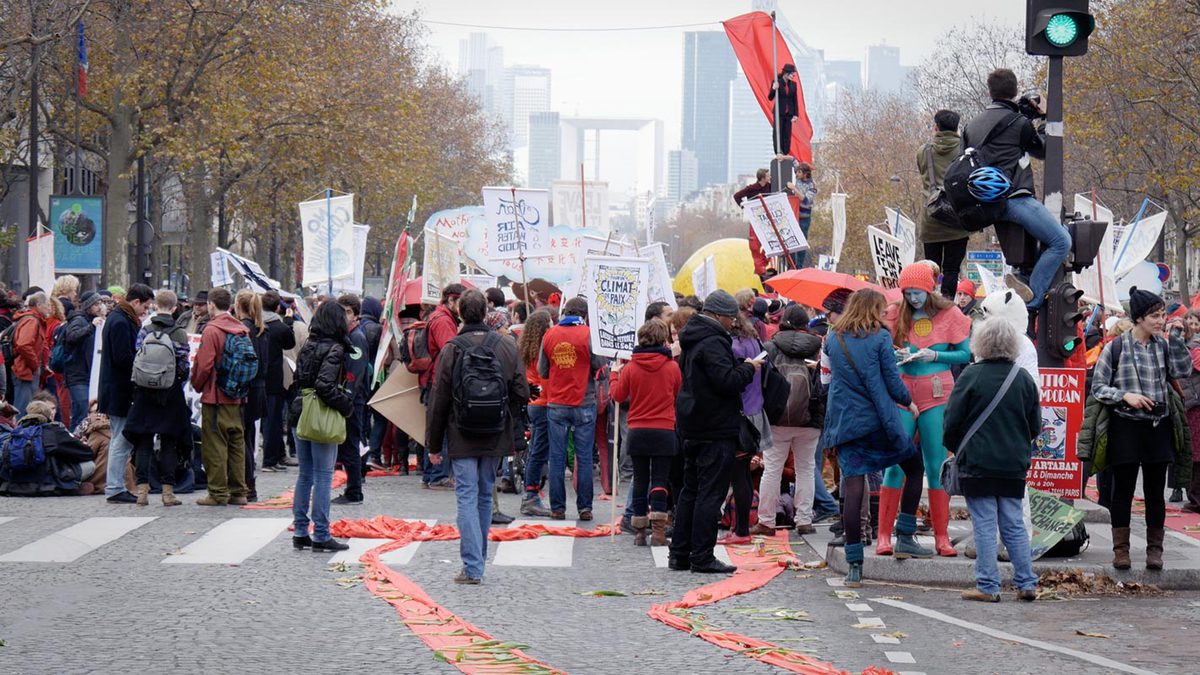
Oliver Ressler, “Everything’s coming together while everything’s falling apart: COP21”, 17 min., 4K, 2016. Courtesy the artist, àngels Barcelona, The Gallery Apart, Rome
The effects of human activities on climate change seem to be irreversible, nevertheless, no one can blame the mankind as a singular entity. The main culprit must be the entire capitalist system based on “accumulation for accumulation’s sake”7 without taking into account severe depletion of resources and devastating effects on the environment. Jason Moore’s notion of capitalocene8 indicates that capitalism must be understood not only as a type of market economy and as a social system of class division, but also as a mode of the reorganization of nature. From the early modern origins of capitalism, Moor is following transformation patterns of governance of nature by a set of production conditions which he named “Cheap nature” (the Four Cheaps—labour-power, food, energy and raw materials). Thus, it is paramount to understand that the effects of climate change are not something that is lurking in the future—they are not only immediately present but have a lengthy past. Events such as vast forest fires in Amazonia, Australia, Canada and Siberia during 2019 and 2020, well-documented progressive glacier and permafrost melting, global sea-level rise, and so on, are only one part of the problems caused by the climate change and greenhouse effect. They are indicators that large areas of our planet will cease to be habitable and that this would cause hundreds of millions of people to lose the means to sustain their basic living conditions, thus resulting in waves of forced migrations and probably wars over controlling the leftover resources. Catastrophic global warming is also an effect of deforestation caused by commercial logging since trees are the main absorbers of carbon. Deforestation also means the destruction of animal and plant habitats, and in conjunction with pollution and the usage of pesticides, it causes the extinction of a large number of species. Therefore, Roos claims that capitalism is the embodiment of the sixth mass extinction and insists that we cannot come to terms with the effects of climate change unless we insist on the change of the entire socio-economic system.9
Everything’s Coming Together While Everything’s Falling Apart
The series of—for the time being—six films under the common title Everything’s Coming Together While Everything’s Falling Apart10 is documenting key events in the struggles of the global movement for climate justice. As Ressler explained, the title is referring to a situation in which we have all the necessary technological means to stop using fossil fuels. When such a decision will be made depends on social movements’ pressure on decision-makers, governments and large corporation executives. Ressler builds the narrative in his films by juxtaposing shots of landscapes, activists’ illegal actions and their discussions, scenes of resistance and struggle with police forces. The stories are unfolding through the interweaving of conversations between the groups of activists—thus highlighting the importance of collective decision making and acting—with poetic texts written by the author with Matthew Hyland,11 narrated by art historian Renée Gadsden.12 The musical background of the films consists of songs sung by the activists during their actions. The feelings of togetherness and the collective joy those new forms of protest bring about have a vital significance.
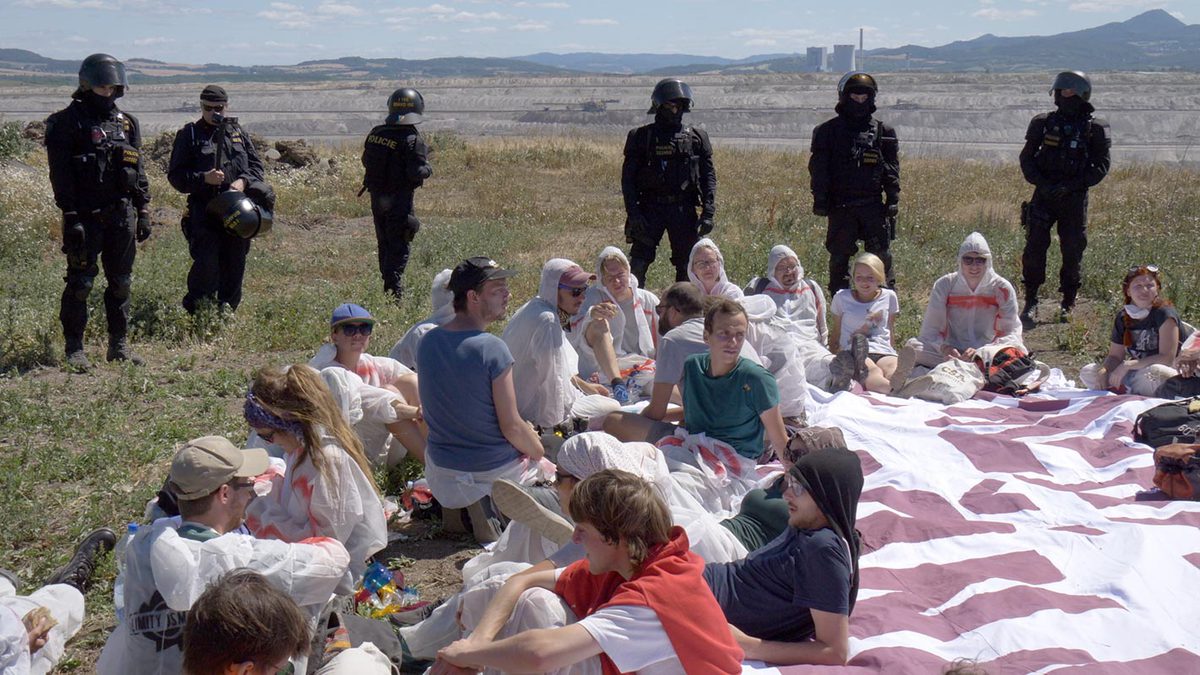
Oliver Ressler, “Everything’s coming together while everything’s falling apart: Limity jsme my”, 10 min., 4K, 2019. Courtesy the artist, àngels Barcelona, The Gallery Apart, Rome
The first of the films in the series, entitled Everything’s Coming Together While Everything’s Falling Apart: COP2113 (17 min., 2016) was shot during the UN COP conference held in December 2015 in Paris, at which the authorities declared a state of emergency. The COP21 conference, despite its more than 100 meetings, was not able to produce even one requisite treaty by which the participating states would guarantee a reduction in CO2 emission. The film begins with the words of an activist: “We know that our addiction to oil is our addiction to war. And the same criminals in the governments who do not represent us—the negotiators at Le Bourget, who had neither the courage nor the political will to reach a climate justice agreement—these same criminal governments repeatedly take us into war for resources, war for oil in Iraq and in many other places.” The connection between the struggle for resources and a global war that was made here is an irrefutable fact for quite some time now. Ressler’s editing style consists here of intertwining footage of activist gatherings and their protesting actions on the streets, thus depicting the energy and strength of the movement for climate justice, with the repressive actions of the state conducted by the riot police. According to the protest plan, the actions took place between two arches of Paris—the Arc de Triomphe, a symbol of the old empire and war, and the arch of La Défense, a symbol of a new empire of capital situated in the middle of the financial district. The space between those two arches was used by the protestors as the field for drawing a “red line” with their own disobedient bodies. The film at one point shows activists dressed in polar bear costumes thus taking the role of one of the most endangered species by the effects of global warming. That footage is mixed with shots of activists holding up shields ornamented with the image of planet Earth while chanting “We are Nature defending itself” which became one of the mottos of the movement for climate justice. The film also comprises scenes of large wind turbines fields that generate electricity, which reminds us that there are technologies already in usage that can replace fossil fuels. Nevertheless, this motif of wind turbines remains the only one of this sort in all the films.
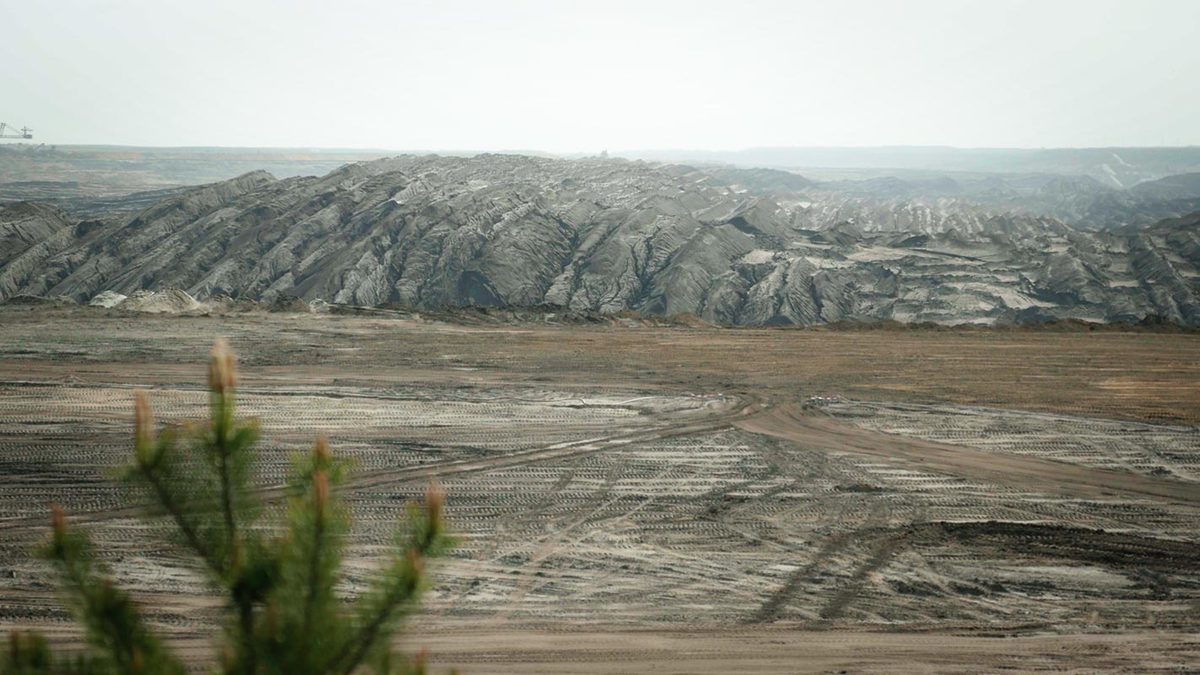
Oliver Ressler, “Everything’s coming together while everything’s falling apart: Ende Gelände”, 12 min., 4K, 2016. Courtesy the artist, àngels Barcelona, The Gallery Apart, Rome
The film Everything’s Coming Together While Everything’s Falling Apart: Ende Gelände14 (End of the Road)15 (12 min., 2016) concerns mass civil disobedience in the form of direct action in Lusatia lignite mines near Berlin. The mine supplies lignite for one of the ten largest thermal power plants in Europe owned by the Swedish consortium Vattenfall. The film begins with a scene depicting deforested and barren landscape traversed by the railroad connecting the lignite mine and the thermal power plant. The voiceover recites the sequence of words “Terra, terraforming, defiling, de-fault forming, terraform terror, terradeforming,” pointing out the connection between forming and deforming earth in the process of coal extraction. It continues with a series of questions: “What will happen? What can happen? How can a particular future happen?” While one of the activists informs others about the action plan, the camera focuses on other activists wearing white overalls practicing nonviolent ways of stopping police interventions. The film further follows the illegal action of over 4000 activists that in the end forced the owners to stop production in the power plant. The nonviolent action consisted of a sit-in on the railroad tracks that succeeded to cut the supply of lignite to the “Schwarze Pumpe” power plant. The voiceover states “You don’t make history by someone’s kind permission,” summarizing the significance of actions for the development of collective futures. Unlike destructive and life-threatening investments of companies that profit from the extraction of fossil fuels, such illegal actions of civil disobedience are concerned with making life possible in the coming times. Certainly, the legality of such actions can always be brought into question, but the question of legitimacy is far more important than the former. The voiceover concludes: “Worldwide ecology will only ever be rebalanced if worldwide production of wealth is likewise upheaved.”
The film entitled Everything’s Coming Together While Everything’s Falling Apart: The ZAD16 (36 min., 2017) is bringing the story of one of the largest autonomous areas in Europe, situated in the vicinity of Nantes, France. Opening shots of the film made from the air depict the green landscape of meadows and forests of the ZAD (zone à défendre—zone to defend).17 Activist John Jordan18 explains that an airport was planned to be built there in that year, as he is showing the areas intended for the control tower and the duty-free shop. The narrative is driven by dialogues between five activists living on the ZAD, and the everyday activities of more than 250 people living in the commune. A reoccurring image is a lighthouse tower, symbolizing a dystopian vision of the future where the ZAD’s territory would be surrounded by sea due to the sea-level rise caused by global warming. Thus, the ZAD could be seen as a lighthouse illuminating the horizon of our future since it indeed represents a successful example of social self-organization. The following sequences show car wrecks as well as the barricades that were left after the clash between the locals and the police forces in 2012, including footage of the struggles against the attempt to evict the residents of the ZAD. The attack led by the police under the code name “Operation César” involved 15,000 policemen sent to tear down houses and huts in the area. The activists emphasize the irony in naming this police action “César” since it took place in Brittany, the homeland of the Gaels. The conflict between police forces equipped with demolition machinery and the bare-handed population stopping the destruction of their homes while singing peace songs proved the strength of the resistance. Its success in pushing back the eviction order was also the result of the solidarity action of around 40,000 people who participated in the resistance and later got involved in rebuilding torn-down houses and structures. This collective solidarity action brought together local farmers and workers on strike from neighboring factories with the larger population of the Nantes district that helped in blocking roads and bridges as well as organizing protests in the city center that gathered over 10,000 people. The film further depicts the mode of functioning of social self-organization in the ZAD as it brings together people with different world-views and habits such as farmers and cattle breeders with anti-speciests that oppose the exploitation of animals. Thus, decision making involves rather complex arbitration processes as the responsibilities are not equally distributed. Obviously, such successful examples of communitarianism are seen as the biggest threat to the still ruling politics of the nation-state and capitalist forms of governmentality.
The film Everything’s Coming Together While Everything’s Falling Apart: Code Rood [Code Red]19 (14 min., 2018) begins with images of a ship in Amsterdam’s harbor. Shots of ships, sea, machinery and huge piles of coal make up the background for the voiceover: “A fleet of Deathships is sinking. Time to go overboard or follow the Fossil Admirals, the Oil and Coal Commanders down to the flooded basement of hell.” The coal terminal OBA Bulk in Amsterdam is the second largest in Europe and it is now in the ownership of the Carlyle Group. The film continues with shots of activists marching in their recognizable white overalls while chanting “We are Nature defending itself.” The black of the coal contrasts the white silhouettes while they work on writing down “SHUT SHIT DOWN” and singing “Leave it in the ground.” The action of the activists managed to shut down the terminal in June 2017, thus once again demonstrating the significance of the climate movement collective activities for sustainable life on the planet. The imperative is to stop the exploitation and distribution of coal before it reaches thermal power plants. The narrator is stating: “There’s nothing ‘anthropocenic’ about global heat-death. Its lifespan is the same as capital’s. The promised apocalypse is capitalocenic. In the end the return on investment looked a lot like an exterminating angel.”
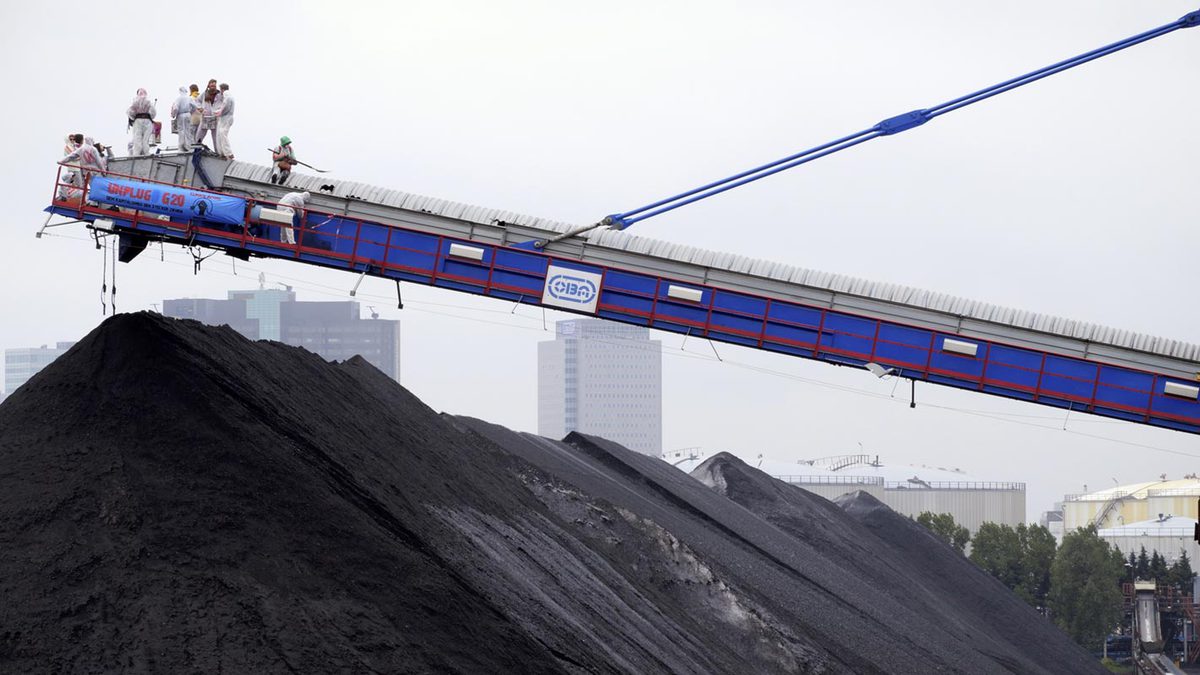
Oliver Ressler, “Everything’s coming together while everything’s falling apart: Code Rood”, 14 min., 4K, 2018. Courtesy the artist, àngels Barcelona, The Gallery Apart, Rome
The film Everything’s Coming Together While Everything’s Falling Apart: Limity jsme my [We Are the Limits]20 (10 min, 2019) begins with a scene shot from a police vehicle depicting a devastated landscape populated with various machines used in the process of coal extraction. The film was made in June 2018 during the blockade action in the Bilina coal mine in Northern Bohemia, Czech Republic. The next sequences show a group of activists in white overalls sitting on the ground and chanting while surrounded by police forces: “Gas, oil and coal must stay in the ground—every last particle. We are the limits!” The background of this scene is the infrastructure of the mine and the land devastated by heavy machinery. While activists are deliberating whether to stop or continue with their nonviolent action, the police are warning them from a loudspeaker mounted on the top of one of the patrol cars to follow their instructions as they are trespassing. The voice of the narrator states: “The more the social order loses credit, the more it arms its police.” During the police action that stopped the nonviolent blockade of the open-pit mine Bilina, 260 activists of 400 in total were arrested. In March 2019, the ČEZ Group that owns the mine sued the organizers of the blockade as well as 91 other persons, although some of them were not even present at the time. The film ends with a scene similar to the one at the beginning—a devastated landscape shot from a police vehicle transporting the detained activists with Ressler among them.
The sixth film of the series is entitled Everything’s Coming Together While Everything’s Falling Apart: Venice Climate Camp (21 min, 2020). It was shot in September 2019 during the Venice climate camp,21 the first of that kind in Italy, organized by No Grandi Navi (No Big Ships)22 in collaboration with Fridays for Future from Vicenza and other activist groups from the EU. One month after the camp Venice was flooded thus proving that the problem of rising sea levels is real and imminent. At the beginning of the film the participants of this activist gathering highlight that the “apocalypse” of climate change is not some future possibility but has already happened for populations in Africa and the Philippines, as well as for many other countries of the global South. The relocation of the “big catastrophe,” bound to happen in the future, to the underdeveloped countries is driven by class, racial and colonial logic that is obscuring a clear comprehension of today’s world that already reached cataclysmic proportions of CO2 emission. The scene that begins with the sound of a siren coming from a cruise ship serves as an introduction to the action of 200 people that occupied in the early morning hours the red carpet on the 76th Venice film festival. The action was not aimed at the festival itself, since the activists’ intention was to use its media coverage to highlight the problem of the ecological crisis as an effect of climate change. While the camera is following the activists in white overalls as they take over the red carpet, the narration consists of activists’ speeches that draw the attention to the necessity to change a system based on market logic. Scenes of activists singing and shouting slogans are followed by those of armed police forces surrounding them. During the protest which took place in front of the Venice Biennale Board office, a critique of the Venice Biennale of art was also voiced by curator and art theorist Marco Baravalle,23 who was denouncing the biennial’s effort to ideologically interpellate24 artists who are critically oriented while being entirely silent on the global issues that we are all facing: “The biennale missed a great, important and fundamental opportunity to stand firmly for climate justice today. And this reminds us how necessary we are as a climate justice movement, as a social movement. You know the biennale and all these cultural institutions are full of films or works of art which are radical, which are beautiful. But it is also a cultural institution of capitalism. They show radical art, but when it’s time to clearly step up, when they face something that is not a cultural product, they are silent in a very shameful way. That’s why, especially with climate justice, we can’t be satisfied with the fact that media are talking about it, with media representation of climate crisis—we need a radical action exactly like our action today. So, to the biennale, I would say ‘Shame on you!’” The last scene of the film is depicting activists chanting while leaving the red carpet: “We are unstoppable—Another world is possible,” a motto that was also used in previous actions.
The problems in connection to the global climate changes are progressively becoming important issues that contemporary art seeks to confront. The most important point in Oliver Ressler’s films is his focus on numerous mass protests against climate change that show a rise in consciousness about the growing climate crisis. Moreover, Ressler is making a step further in such efforts by advocating an unambiguous political agenda as well as by bringing actions, often rendered as illegal, to the fore. Those actions, although often deemed lawbreaking, are made against activities that are criminal in the sense that they further aggravate the already ongoing climate changes. Ressler’s artistic depictions of the protest actions is a strong political gesture since they point out the significance of solidarity in the common struggle and insistence in demanding changes in our political system that would stop climate change and thus open future horizons for the coming generations.
Editor: Vincent Simon
Translated from Serbian by Dušan Grlja
Cover: Oliver Ressler, “Everything’s coming together while everything’s falling apart: The ZAD”, 36 min., 4K, 2017. Courtesy the artist, àngels Barcelona, The Gallery Apart, Rome
